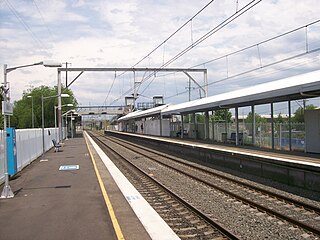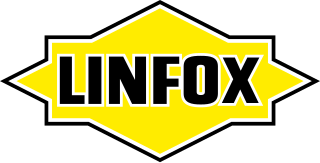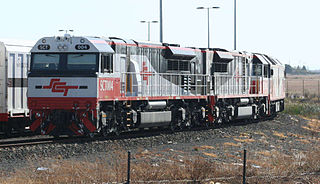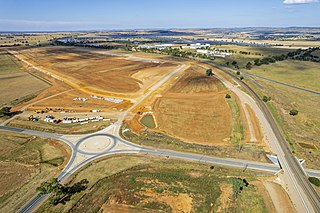
The Adelaide–Darwin railway line is a railway line in Australia, between the South Australian town of Tarcoola and the Northern Territory city of Darwin. Preceded by a number of other shorter railways, a line through to Darwin was fully realised in 2004 when the final link from Alice Springs to Darwin was opened. Forming the main section of the 2,975 kilometres (1,849 mi) rail corridor between the cities of Adelaide and Darwin, the line is used by The Ghan passenger train and interstate freight trains operated by Aurizon.

Forrestfield is a suburb of the City of Kalamunda in Western Australia. It lies 15 kilometres to the south-east of Perth at the base of the Darling Scarp and the southern border of Perth Airport.

The Southern Sydney Freight Line (SSFL) is a freight only railway line in the south-western suburbs of Sydney, Australia. The line was built to segregate freight trains from the Sydney Trains network. It forms part of a dedicated freight only corridor between Port Botany and Macarthur. The line is managed by the Australian Rail Track Corporation.

Minto railway station is located on the Main Southern line, serving the Sydney suburb of Minto. It is served by Sydney Trains T8 Airport & South line services.

Linfox is an Australian transport and logistics and supply chain business founded in 1956 by Lindsay Fox.
Aurizon Holdings Limited is a freight rail transport company in Australia, formerly named QR National Limited and branded QR National. In 2015, it was the world's largest rail transporter of coal from mine to port. Formerly a Queensland Government-owned company, it was privatised and floated on the Australian Securities Exchange (ASX) in November 2010. The company was originally established in 2004–05 when the coal, bulk, and container transport divisions from Queensland Rail were brought under one banner as QR National.

Transport in Sydney is provided by an extensive network of public transport operating modes including metro, train, bus, ferry and light rail, as well as an expansive network of roadways, cycleways and airports. According to the 2006 census, in terms of travel to work or study Sydney has the highest rate of public transport usage among the Australian capital cities of 26.3% with more than 80% of weekday trips to/from Central Sydney being made by public transport. According to the New South Wales State Plan, the state has Australia's largest public transport system. The public transport network is regulated by Transport for NSW.

SCT Logistics is an Australian interstate transport company operating rail and road haulage, with facilities in Brisbane, Sydney, Parkes, Melbourne, Adelaide and Perth.

The rail network of Melbourne, Australia, has a significant number of railway lines and yards serving freight traffic. Rail transport in Victoria is heavily focused on Melbourne, and, as a consequence, much of the state's rail freight passes through the metropolitan network.
CRT Group is an intermodal transport company in Australia. It was founded in 1954 as Colin Rees Transport, a taxi truck company in Sydney. In 1981 it became known as the CRT Group, and by the time of its acquisition by QR National in June 2005, was in the top 10 logistics companies in Australia with a turnover of $80 million, and moving over 600,000 tonnes of freight a year. The company specialised in the movement of food products, polymers, and plastics.

Port Botany is a deepwater seaport located in Botany Bay in Sydney, Australia. The port is dominated by trade in containerised manufactured products and, to a lesser extent, bulk liquid imports including petroleum and natural gas. It is one of Australia's largest container ports and is administered by NSW Ports which entered into a 99-year lease agreement with the Port Authority of New South Wales in May 2013.

The GT46C-ACe is a model of Australian diesel-electric locomotive designed and built between 2007–present by Downer Rail at its Cardiff Locomotive Workshops using Electro-Motive Diesel components until 2014, with later units built in Muncie, Indiana.

Independent Rail of Australia was an accredited railway freight operator in New South Wales, Australia.

Qube Holdings is a diversified logistics and infrastructure company in Australia.

Watco Australia is a rail haulage operator that was formed in 2010 to haul grain for the CBH Group in Western Australia. In 2019, it commenced operating in Queensland under a contract with GrainCorp. It is a subsidiary of Watco.

The Riverina Intermodal Freight & Logistics Hub is an Australian dry port in the northern Wagga Wagga suburb of Bomen adjacent to the Main Southern railway line.
The Holsworthy railway line was located in South-western Sydney. It was constructed during World War I, mainly using labour from the Holsworthy Internment Camp. Its purpose was to service the Holsworthy army facilities opening on 21 January 1918.
The 2010s saw many developments relating to transport in the Australian city of Sydney, New South Wales. The decade saw a substantial investment in infrastructure, including a new airport, motorway projects, light rail lines, Australia's first metro system, the new Waratah fleet and the demise of the non-air conditioned S sets from the rail network. Planning and branding of public transport services became substantially more centralised.
Linx Cargo Care Group is a transportation and logistics company in Australia and New Zealand, headquartered in Sydney.














